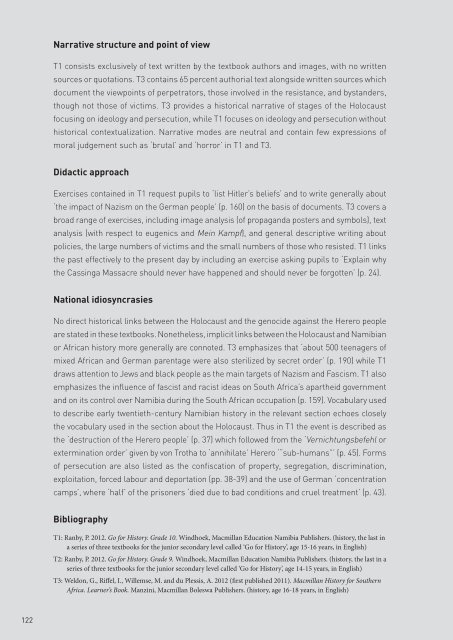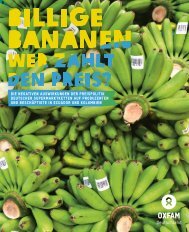228776e
228776e
228776e
Create successful ePaper yourself
Turn your PDF publications into a flip-book with our unique Google optimized e-Paper software.
Narrative structure and point of view<br />
T1 consists exclusively of text written by the textbook authors and images, with no written<br />
sources or quotations. T3 contains 65 percent authorial text alongside written sources which<br />
document the viewpoints of perpetrators, those involved in the resistance, and bystanders,<br />
though not those of victims. T3 provides a historical narrative of stages of the Holocaust<br />
focusing on ideology and persecution, while T1 focuses on ideology and persecution without<br />
historical contextualization. Narrative modes are neutral and contain few expressions of<br />
moral judgement such as ‘brutal’ and ‘horror’ in T1 and T3.<br />
Didactic approach<br />
Exercises contained in T1 request pupils to ‘list Hitler’s beliefs’ and to write generally about<br />
‘the impact of Nazism on the German people’ (p. 160) on the basis of documents. T3 covers a<br />
broad range of exercises, including image analysis (of propaganda posters and symbols), text<br />
analysis (with respect to eugenics and Mein Kampf), and general descriptive writing about<br />
policies, the large numbers of victims and the small numbers of those who resisted. T1 links<br />
the past effectively to the present day by including an exercise asking pupils to ‘Explain why<br />
the Cassinga Massacre should never have happened and should never be forgotten’ (p. 24).<br />
National idiosyncrasies<br />
No direct historical links between the Holocaust and the genocide against the Herero people<br />
are stated in these textbooks. Nonetheless, implicit links between the Holocaust and Namibian<br />
or African history more generally are connoted. T3 emphasizes that ‘about 500 teenagers of<br />
mixed African and German parentage were also sterilized by secret order’ (p. 190) while T1<br />
draws attention to Jews and black people as the main targets of Nazism and Fascism. T1 also<br />
emphasizes the influence of fascist and racist ideas on South Africa’s apartheid government<br />
and on its control over Namibia during the South African occupation (p. 159). Vocabulary used<br />
to describe early twentieth-century Namibian history in the relevant section echoes closely<br />
the vocabulary used in the section about the Holocaust. Thus in T1 the event is described as<br />
the ‘destruction of the Herero people’ (p. 37) which followed from the ‘Vernichtungsbefehl or<br />
extermination order’ given by von Trotha to ‘annihilate’ Herero ‘“sub-humans”’ (p. 45). Forms<br />
of persecution are also listed as the confiscation of property, segregation, discrimination,<br />
exploitation, forced labour and deportation (pp. 38-39) and the use of German ‘concentration<br />
camps’, where ‘half’ of the prisoners ‘died due to bad conditions and cruel treatment’ (p. 43).<br />
Bibliography<br />
T1: Ranby, P. 2012. Go for History. Grade 10. Windhoek, Macmillan Education Namibia Publishers. (history, the last in<br />
a series of three textbooks for the junior secondary level called ‘Go for History’, age 15-16 years, in English)<br />
T2: Ranby, P. 2012. Go for History. Grade 9. Windhoek, Macmillan Education Namibia Publishers. (history, the last in a<br />
series of three textbooks for the junior secondary level called ‘Go for History’, age 14-15 years, in English)<br />
T3: Weldon, G., Riffel, I., Willemse, M. and du Plessis, A. 2012 (first published 2011). Macmillan History for Southern<br />
Africa. Learner’s Book. Manzini, Macmillan Boleswa Publishers. (history, age 16-18 years, in English)<br />
122




